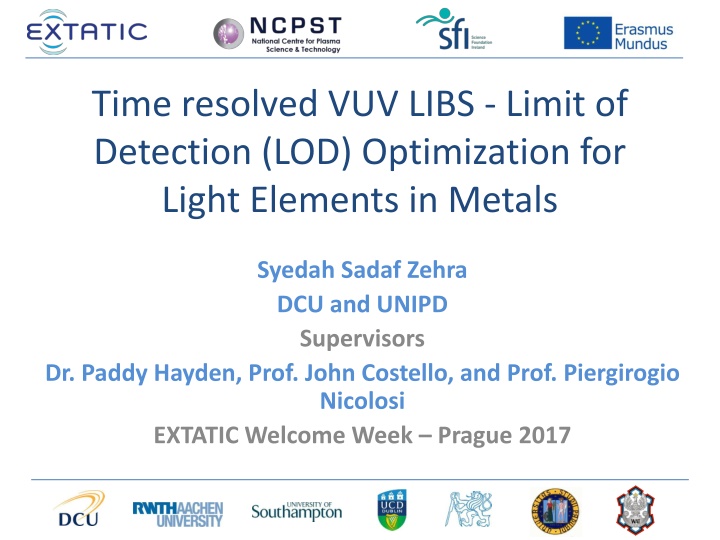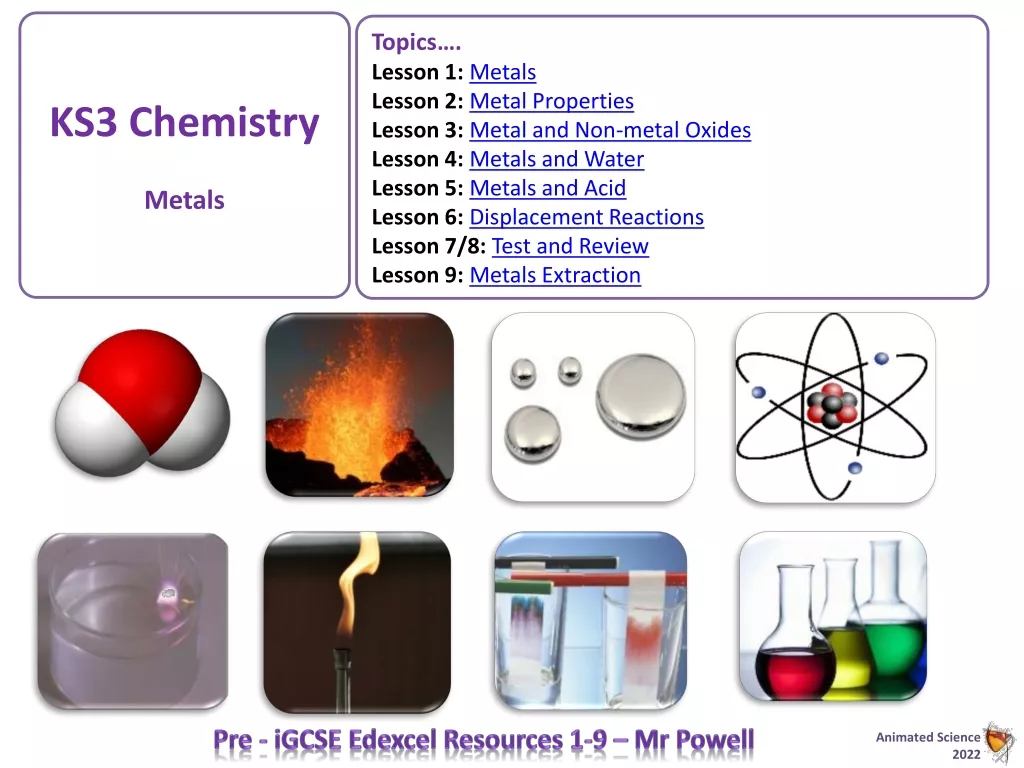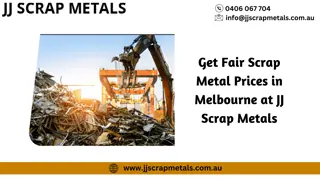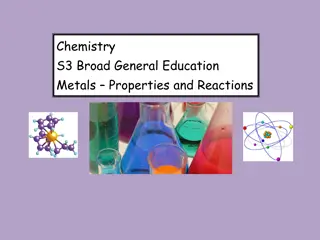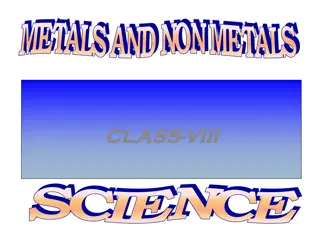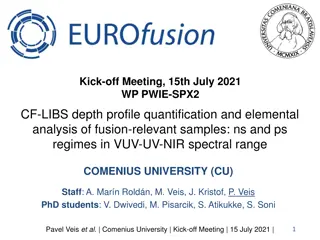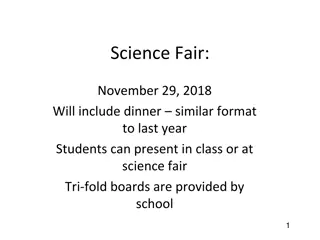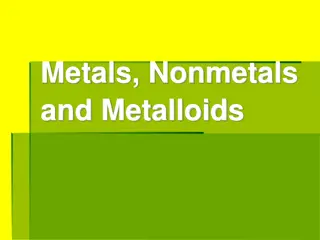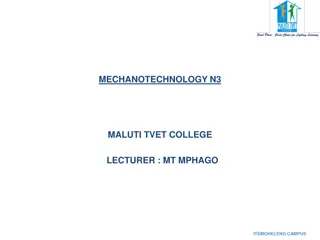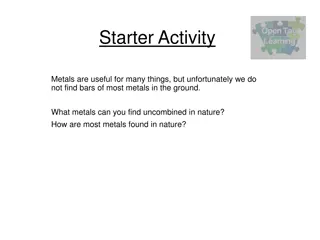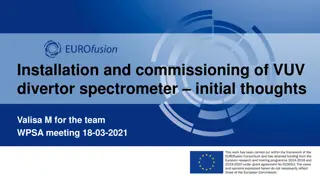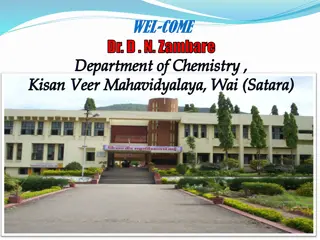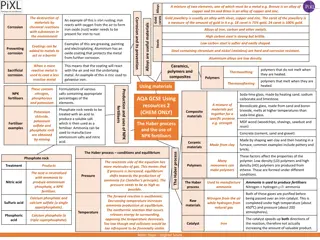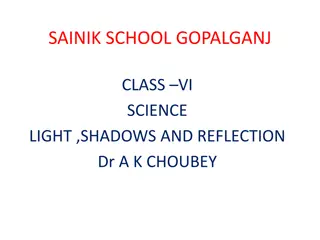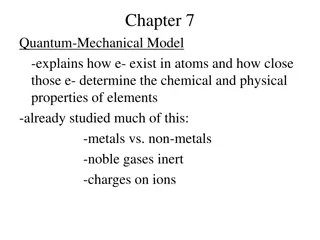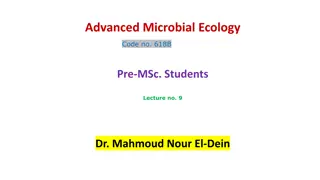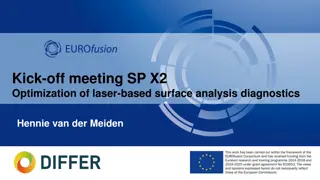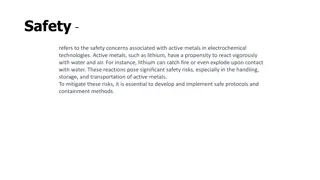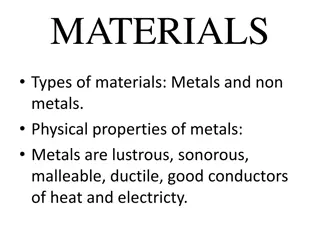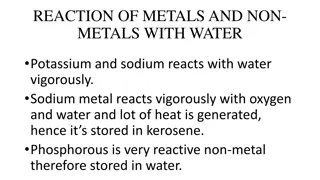Optimizing LOD in Time-Resolved VUV LIBS for Light Elements in Metals
Laser-Induced Breakdown Spectroscopy (LIBS) is a powerful analytical method used to detect elemental composition in various states. This research focuses on optimizing the Limit of Detection (LOD) for Time-Resolved Vacuum Ultraviolet (VUV) LIBS, particularly for light elements in metals. The study aims to enhance the LOD for metals such as carbon and sulfur, achieving impressive results through dual-pulse techniques. Through detailed research objectives, roadmaps, and experimental setups, the investigation explores the potential of Time-Resolved VUV LIBS in depth profiling thin metallic films. The findings showcase improvements in signal-to-noise ratio and ablation rates, highlighting the effectiveness of the Time-Resolved LIBS approach.
Download Presentation

Please find below an Image/Link to download the presentation.
The content on the website is provided AS IS for your information and personal use only. It may not be sold, licensed, or shared on other websites without obtaining consent from the author.If you encounter any issues during the download, it is possible that the publisher has removed the file from their server.
You are allowed to download the files provided on this website for personal or commercial use, subject to the condition that they are used lawfully. All files are the property of their respective owners.
The content on the website is provided AS IS for your information and personal use only. It may not be sold, licensed, or shared on other websites without obtaining consent from the author.
E N D
Presentation Transcript
Time resolved VUV LIBS - Limit of Detection (LOD) Optimization for Light Elements in Metals Syedah Sadaf Zehra DCU and UNIPD Supervisors Dr. Paddy Hayden, Prof. John Costello, and Prof. Piergirogio Nicolosi EXTATIC Welcome Week Prague 2017
Outline Introduction Research Aim Research Objectives LOD Optimization Results & Discussion Conclusion Depth Profiling Using LIBS Introduction Experimental Setup Results and Discussion Conclusion Future Work
Introduction Laser Induced Breakdown Spectroscopy (LIBS)? - Analytical method to detect elemental composition of solid, liquid, and gases (qualitatively and quantitatively). Laser focused on to target to form plasma Spectral line intensities determine elemental composition
Research Aims Optimisation of Limit of Detection (LoD) for Time Resolved VUV LIBS Characterisation of metals (such as depth profiling) using VUV LIBS system. Dual pulse Optimized LOD obtained for Carbon is 3.6 ppm 0.3 ppm and Sulphur 1.5 0.1 ppm using time integrated system previously in DCU*. *X. Jiang, P. Hayden et al., Spectro. Acta B 86, 66 (2013)
Research Objectives Time Resolved vs Time Integrated LIBS Comparison LIBS Exploration of Time Resolved VUV LIBS for LOD Optimization Application in Depth Profiling of thin Metallic films
Research Road Map TR LIBS Dual Pulse Time Integrated Depth Profiling Depth Profiling Time Integrated Time Resolved LOD Optimizati on Time Resolved Dual Pulse Time Resolved LIBS Time Resolved Vs Time Integrated LIBS Application in depth profiling Dual Pulse time resolved LIBS for limit of detection optimization. Time Resolved System shows better Signal to Noise ratio Crater size and ablation rate of thin metallic films was calculated .
Outline Introduction Research Aim Research Objectives LOD Optimisation Results and Discussion Conclusion Depth Profiling Using LIBS Introduction Experimental Setup Results and Discussion Conclusion Future Work
Results Time integrated plasma emission spectrum Target at 4 mm distance from the spectrometer optical axis 11 pixels integrated around the C III 1s22s2p to 1s22s2 line at 97.7 nm Also background taken as 11 pixels around 104 nm Target at 2 mm distance from the spectrometer optical axis 11 pixels integrated around the C III 1s22s2p to 1s22s2 line at 97.7 nm Also background taken as 11 pixels around 104 nm
Results Time resolved plasma emission results at 2 mm Exit slit width was set to 282 m to have same spectral windows as time integrated analysis Window of 90 ns to 230 ns chosen
Discussion Comparison of analytical quality of three methods for carbon in steel Method R- value LOD Signal / Background Time integrated VUV 0.98837 224ppm 2.4 LIBS at 2 mm Time integrated VUV 0.99988 316ppm 2.8 LIBS at 4 mm Time resolved VUV 0.99985 56ppm 3.3 LIBS at 2 mm
Conclusion Time resolved method shows higher signal to background ratio and lower limit of detection for carbon concentration in steel samples. Provides increase in calibration curve quality.
Outline Introduction Research Aim Research Objectives LOD Optimisation Introduction Experimental Setup Results and Discussion Depth Profiling Using LIBS Introduction Experimental Setup Results and Discussion Conclusion Future Work
Introduction Depth Profiling is a process where the element or chemical content of a sample is measured as a function of depth.
Depth Profiling Techniques Technique Application Advantages Disadvantages Secondary ion mass spectroscopy (SIMS) Solar cells Analysis, Electronic parts Analysis, etc. Good depth resolution around 50 A Not flexible to other wavelengths Auger electron Spectroscopy (AES) Semiconductor nanostructures analysis, etc. Good depth resolution around 10A Not flexible to other wavelengths Glow Discharge Optical Emission Spectroscopy (GD- OES) Solar Cells, Semiconductors, Electronic parts, etc. higher range of depth: from tenths of a micron to a few tens of microns Complicated geometry Laser Induced Breakdown Spectroscopy LIBS Solar Cells, Semiconductors, Electronic parts, etc. Reduced ablation rate to nm scale to characterize thinner layers Mixing of layers of diff compositions
Depth Profiling Using LIBS A laser is fired repetitively over a single position of the sample surface so that the depth- related spectra can be obtained by monitoring the laser induced plasma emission from each laser shot. Plotting of the emission intensities at specific wavelengths against the pulse number yields the depth profiles
Sample Preparation Aluminum foils attached on Silicon substrate (GoodFellow) Different Deposition Techniques (e.g. sputtering, , etc.) Experimental Setup UV spectral range in air VUV spectral range in vacuum Depth Profile Elemental characterisation using spectral recording Numerical calculation of crater size Experimental measurement of crater size( using Optical Microscope) Experimental measurement of crater size (using AFM)
5 Aluminium samples of different thicknesses from 1 mm to 1.5 m attached on uniform silicon substrate are used. Two laser energies are used, with the same focussing conditions. Time resolved LIBS (50 ns delay and 130 ns width) is used to record spectra for the higher power density (1.3 x1010 Wcm-2) to prevent saturation. Time integrated LIBS is used to record spectra for the lower power density (1.6 x 109 Wcm-2).
Outline Introduction Research Aim Research Objectives LOD Optimisation Introduction Experimental Setup Results and Discussion Depth Profiling Using LIBS Introduction Experimental Setup Results and Discussion Conclusion Future Work
Mirror Laser Half wave plate Laser Nd:YAG 6.0ns 730 mJ 1064 nm 40 m 1.3x1010 Wcm-2 1.6x109 Wcm-2 Polarizer Lens Polarizer Half wave plate Plasma Target Mirror Data ICCD Collecting Optics Acquisition and Analysis Shamrock Fibre Optics
Outline Introduction Research Aim Research Objectives LOD Optimisation Introduction Experimental Setup Results and Discussion Depth Profiling Using LIBS Introduction Experimental Setup Results and Discussion Conclusion Future Work
Typical Spectrum 1 Al I 3s24s to 3s23p 0.9 0.8 Al I 3s24s to 3s23p Intensity (arb. units) 0.7 0.6 0.5 0.4 0.3 Si I 3s23p4s to 3s23p2 0.2 0.1 0 385 390 395 400 405 Wavelength (nm) Si I 3s23p4s to 3s23p2at 390.55 nm Al I 3s24s to 3s23p at 394.40 nm Al I 3s24s to 3s23p at 396.15 nm
Aluminium Intensity at Higher Power Density (1.3 x1010 Wcm-2 ) 2.2 2 1 mm 1.8 Al intensity (arb. units) 45 m 1.6 30 m 15 m 1.5 m 1.4 1.2 1 0.8 0.6 0.4 0.2 10 20 30 40 50 60 70 80 Shot number
Silicon Intensity at Higher Power Density (1.3 x1010 Wcm-2 1.6 1 mm 45 m 1.4 30 m 15 m 1.5 m 1.2 Si intensity (arb. units) 1 0.8 0.6 0.4 0.2 0 10 20 30 40 50 60 70 80 Shot number
Target thickness Ablation Count (No of shots) 1 mm ( Red) _ 45 m (Blue) 33-39 shots 30 m (Black) 22-26 shots 15 m (Magenta) 9-13 shots 1shot 1.5 m( Green) Ablation rate =1.3-1.7 m/shot
Aluminium Intensity at Low Power Density (1.6 x 109 Wcm-2). 1 mm 1.2 45 m 30 m 15 m 1.5 m Al intensity (arb. units) 1 0.8 0.6 0.4 0.2 0 20 40 60 80 100 120 140 160 Shot number
Silicon Intensity at Low Power Density (1.6 x 109 Wcm-2). 0.2 1 mm 45 m 0.15 30 m 15 m 1.5 m Si intensity (arb. units) 0.1 0.05 0 -0.05 -0.1 20 40 60 80 100 120 140 160 Shot number
Target thickness Ablation Count (No of shots) 1 mm ( Red) 45 m (Blue) 74-77 shots 30 m (Black) 50-59 shots 15 m (Magenta) 23-27 shots 1.5 m( Green) 2-3 shots Ablation rate = 0.51-0.66 m/shot
1st shot After 30 shots After 15 shots Light Test 1.5 micron foil
Outline Introduction Research Aim Research Objectives LOD Optimisation Introduction Experimental Setup Results and Discussion Depth Profiling Using LIBS Introduction Experimental Setup Results and Discussion Conclusion Future Work
Time Resolved and Time Integrated LIBS of Aluminum samples is performed at high and low power densities The ablation rate of Al using low power density is 0.51-0.66 m/shot The ablation rate of Al using high power density is 1.3-1.7 m/shot Typical Al spectrum with high signal to noise ratio can be recorded with only 10 to 24 shots (in 1-2.4 seconds) using high and low power densities Initial results encourage to investigate further crater geometry to understand plasma properties, laser material coupling and LIBS emission
Outline Introduction Research Aim Research Objectives LOD Optimisation Introduction Experimental Setup Results and Discussion Depth Profiling Using LIBS Introduction Experimental Setup Results and Discussion Conclusion Future Work
Data Acquisition ICCD/Scintillator Spectrometer Target GCA Plasma GCA Parabolic Mirror Parabolic Mirror Pumping system Lens
Future work Examine dual pulse LIBS with time resolution for steel and aluminium. Using Coefficient Correlation method at low Power density to get better signals. (Ref T Nagy et al Applied surface science 2016) Depth profiling of metallic thin films in Vacuum. Visit UNIPD under EXTATIC mobility programme produce and characterise thin films to use in DCU for depth profiling with VUV LIBS. Using different comparative techniques with LIBS like Secondary Ion Mass Spectroscopy to compare it with LIBS results.
Modules Completed FSH502 Extatic Fundamental Module FSH505 EUV Optics MM600 Labview, Advance Acquisition of data and Control CS507A Advanced Statistics and Chemometric Safelab 1&2 Researcher Module Enrolled FSH508 EUV and X-Ray Metrology
Acknowledgement Paddy Hayden , John Costello, Piergiorgio Nicolosi and Group members NCPST. Supported by: Work supported by the Education, Audiovisual and Culture Executive Agency (EACEA) Erasmus Mundus Joint Doctorate Programme Project No. 2012 0033.
